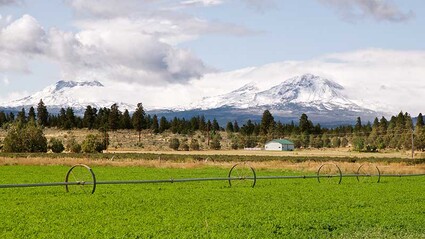Winter is coming: Tame or tumultuous?
Last updated 10/8/2019 at Noon

Jerry Baldock
The Three Sisters got an early blanket of snow. It may not signify much in terms of the winter forecast.
This is the time of the year when key aspects of the atmosphere and ocean begin to emerge that will drive weather patterns in the coming weeks and months. Soon seasonal forecasters will begin evaluating this information, making their own judgments about which sets of data are most important in order to paint a picture of the upcoming winter here in the Pacific Northwest.
Most atmospheric scientists regard the ocean/atmosphere coupled mode, known as the El Niño-Southern Oscillation (ENSO), to be the dominant factor of climate variability and is still the cornerstone of operational seasonal climate forecasts issued worldwide. Specifically, the ENSO is a recurring climate pattern involving changes in temperature and wind direction in the central and eastern tropical Pacific Ocean.
The most commonly used tool to evaluate the state of the ENSO is the Oceanic Niño Index (ONI). It is based on averaging sea surface temperature (SST) anomalies across a given region. ONI values greater than +0.5 constitute an El Niño; those less than -0.5 signify a La Niña. When the ONI is between +0.5 and -0.5 the ENSO is said to be neutral, called by some La Nada.
Prevailing trade winds normally blow across the tropical Pacific Ocean from east to west, causing warm surface water to pile up in the western Pacific. This allows modest upwelling to occur in the eastern Pacific that leads to cooler SSTs. This is the normal state of affairs — the La Nada. When the trade winds strengthen, even more surface water finds itself westward-bound that results in cooler, deeper water rising to the surface in the east — La Niña.
There are times, however, when the trade winds weaken, or even reverse direction and blow from the west. Now the warm surface water collects in the central and eastern Pacific, altering normal weather patterns — El Niño.
Last fall many prognosticators were in a bit of a quandary about what to say regarding the approaching winter. The ENSO signal was neutral at the time but most expected it to morph into a weak El Niño by mid-to-late winter. If ENSO stayed neutral throughout the winter, temperatures and precipitation amounts would likely be about normal in our neck of the woods. An El Niño should mean warmer and drier weather.
The fact is the El Niño arrived by late fall and held sway throughout the winter. And what was the result?
In Central Oregon November temperatures were normal, but it was dry. Precipitation amounts were approximately one inch below normal, most of that falling near the end of the month. December followed suit with normal temperatures and sub-par precipitation amounts.
Except for the last four days of the month, the January 2019 weather data for Sisters is missing. Data from Bend and Sunriver were used in its place. Temperatures were slightly warmer than normal, but unexpectedly wet with amounts about half an inch above normal.
February was chillier and wetter than normal. A cold snap near the end of the month caused the thermometer to register approximately 6 degrees F below normal for the month. And the cold lingered through March. For the month temperatures averaged 10 degrees F below normal, sometimes more than 20 degrees F early in the month. Precipitation amounts were about a quarter of an inch drier than usual.
It’s as if the weak El Niño held its own in November and December, but seemed to lose its grip in January and throughout the remainder of the winter. The good news is that the welcomed moisture greatly alleviated drought conditions here in Deschutes County and other regions of the Northwest.
But let’s set aside last winter’s baggage for a moment and focus on the task at hand, namely trying to figure out the upcoming 2019-20 winter.
El Niño disappeared in August, replaced by La Nada. According to the National Weather Service’s Climate Prediction Center, there is a 55-60 percent chance that the neutral ENSO will persist into the spring of 2020. Climate forecasting is made more difficult when the neutral phase is in play because it introduces a greater level of variability.
Meteorologist Pete Parsons of the Oregon Department of Forestry has issued his outlook for the period from October through December. His analysis favors a cool start and mild end to the three-month period with overall temperatures and precipitation coming in slightly above average. In Central Oregon this translates to near-average precipitation levels in October, drier in November and wetter than normal in December.
He points out that December could be rather stormy, especially west of the Cascades. Parsons updates his forecasts on a monthly basis, on about the 20th. Here’s where his forecast can be found: https://www.oregon.gov/ODA/
programs/NaturalResources/Documents/Weather/
dlongrange.pdf.
The Climate Prediction Center’s forecast for the same three-month period calls for above-normal temperatures throughout the entire country, though more so in the southwest and New England, and below-normal precipitation here in Central Oregon. Other meteorologists/climatologist will chime in with their own winter forecasts in the weeks to come.
It is also worth mentioning that at this time winds that circulate about the polar vortex at the North Pole are strong, which should keep the coldest air in the hemisphere bottled up for a period of about 60 to 90 days. It’s only when these winds weaken that sometimes allows the arctic air to spread southward. Forecasters will keep a close eye on this.
It is unlikely the chilly temperatures and low-elevation snow we experienced at the end of September is a portent of a harsh winter, but might it be indicative of its variability? We’re about to find out.
















Reader Comments(0)